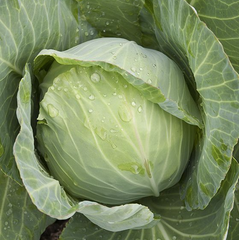Growing Winter Cabbage
Posted January 23, 2020

Cabbage is high in antioxidants and fiber, plus it is the perfect antidote to all the festive indulgence of chocolate and sweets we inflict on ourselves each year during holiday season.
Soil
Just like all the brassica family, cabbages like fertilize soil that have been amended with plenty of compost and/or well rotted manure. If your soil is acidic, add lime to make it more alkaline as this will help to prevent against club root.
Sowing
Sow winter cabbage and winter Savoy cabbage seeds May-June. Sow thinly to a depth of 1/2” with 6” between. When seedlings are about 1” tall, thin them out to 3” apart. Though you can start them off in a cell tray if you prefer.
Growing
When the young plants have their first five leaves, transplant them in their final spot in the garden. 1 foot apart for compact varieties 18” for larger ones. This can be done late June to Mid-July. Savoy cabbages, which can also be sown for winter picking, generally need the larger distances. Water during dry weather and keep wed between plants and rows. In hot climates, it is best to use row cover and transplant on cloudy days or late evening. As cabbage plants grow, earth up soil around the stalks to help prevent the plants from rocking in the wind.
Harvesting
Cabbages can be cut from November onwards. Savoy cabbages are more flavorful if you pick them after a frost. Cut at the base with a sharp knife, cut off the outer leaves and eat healthy!
Pest and Disease
Clubroot: Lime your soil if acidic, or add a dusting to the planting hole.
Cabbage Root Fly: You can protect your cabbages by fitting collars around the stem, or cover with insect netting.
Caterpillars: Cover your cabbages with floating row cover to prevent cabbage white butterflies from laying their eggs, or spray with Spinosad or Bt.



Comments (0 Comments)
There are no comments.
Post Comment